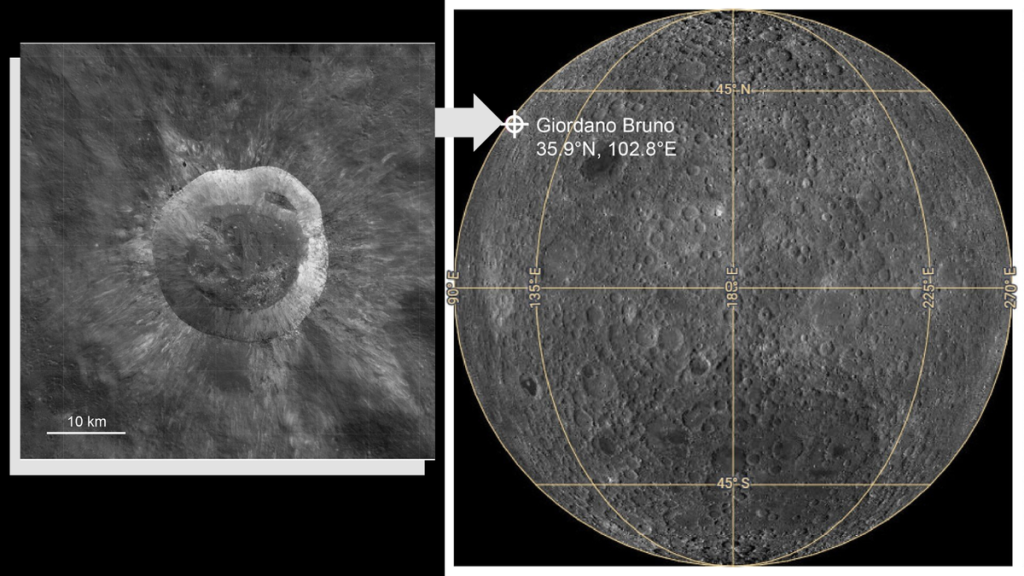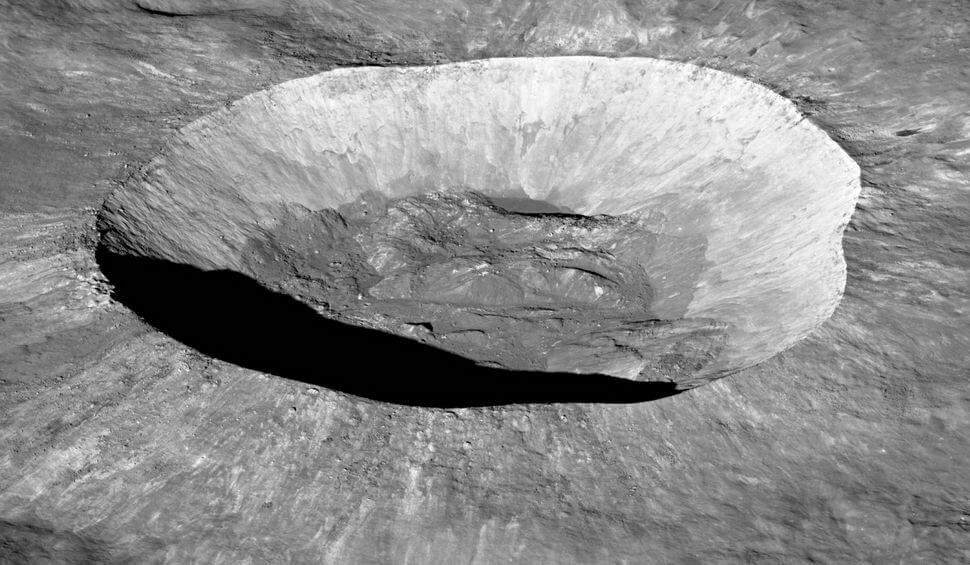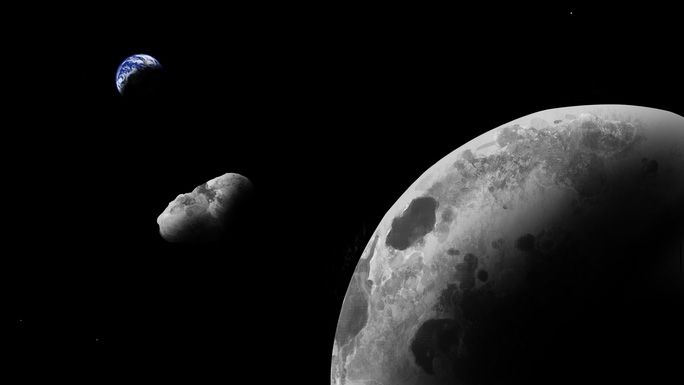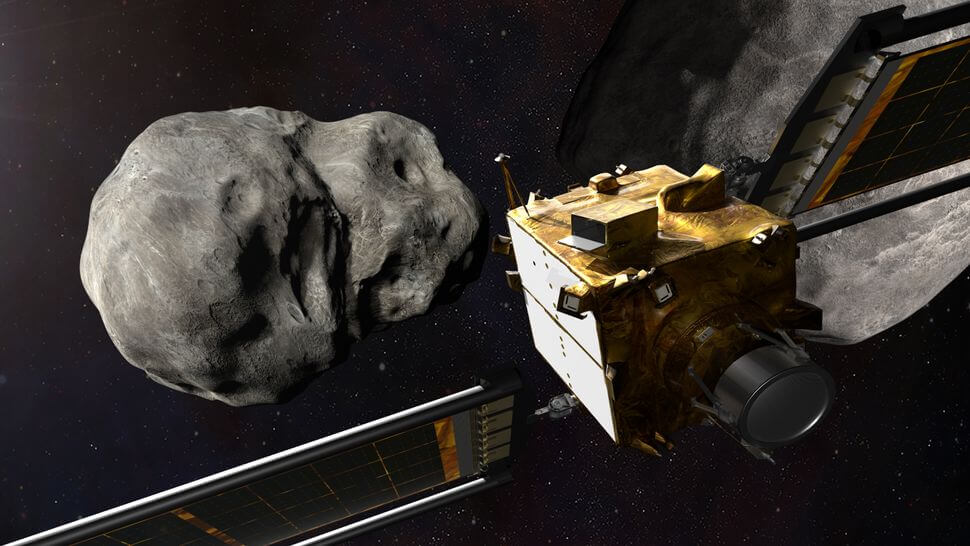
Birthplace of weird Earth ‘quasi-moon’ Kamo’oalewa found (Image Credit: Space.com)
Earth’s “quasi-moon” was likely blasted away from the actual moon relatively recently in the solar system’s history, a new study suggests.
Kamo’oalewa, a 131- to 328-foot-wide (40 to 100 meters) near-Earth object (NEO), was liberated by an asteroid impact between 1 million and 10 million years ago, a smashup that created the moon‘s 13.7-mile-wide (22 kilometers) Giordano Bruno crater, according to the research.
Kamo’oalewa, or “469219 Kamoʻoalewa” as it is officially designated, was discovered in 2016 by the Pan-STARRS 1 asteroid survey telescope on Haleakalā, Hawaii, as part of NASA’s planetary defense effort to discover space rocks that could possibly hit our planet.
Kamo’oalewa, which means “an oscillating celestial object” in Hawaiian, was later found to orbit the sun in synchronization with Earth and is spinning extremely fast for an asteroid. These puzzling characteristics led scientists to investigate the quasi-moon’s origins. In 2021, research revealed that Kamo’oalewa’s composition is similar to rocks recovered from the moon, hinting at its lunar origin. The question was, Where exactly on the moon did it come from?
Related: A ‘quasi-moon’ asteroid companion of Earth may actually be a moon relic
“Our major findings are that Kamo’oaelewa originated from the moon, and not from the asteroid belt, contrary to the majority of asteroids belonging to the NEO population,” Patrick Michel, team member and senior researcher at Centre National de la Recherche Scientifique (CNRS), France’s state research agency, told Space.com.
“Like detectives, we used all known information regarding this Kamo‘oalewa and the lunar surface to derive a scenario for the origin of this object, starting from the impact that produced the Giordano Bruno crater,” Michel said.
The team connected Kamo‘oalewa with the Giordano Bruno crater by working like crime scene investigators. They used a computer model to mimic the type of impact that would have produced a space rock like this quasi-moon.
That meant factoring in things like the size and velocity distributions of the resulting ejecta and their dynamical evolution. This reconstruction demonstrated that some ejecta would eventually get into an orbital 1:1 resonance with Earth, with the same dynamical properties as Kamo’oalewa.
“Our results tell us that Kamo’oalewa is very likely to be a fragment from the lunar surface for which we have a direct relation to a known crater if our scenario is correct,” Michel said.
“Usually, the best we can do is to determine the source region in the asteroid belt of a NEO, knowing its current orbit. A region is usually very wide in these kinds of estimates, such as the inner or outer asteroid belt,” he added. “Here, we identified a very specific body and location where this object comes from, which is very exciting.”

Michel explained that Kamo’oalewa’s orbit is not stable, leading the team to link it to a crater that is not too old, possibly with an age between one and 10 million years.
“Then we also needed the crater to be not too large, so that an intact fragment of the size of Kamo’oaelewa can be produced,” he continued. “The best candidate was then Giordano Bruno, which matches both constraints.”
The team’s impact modeling also gave them an idea of the size of the space projectile that would have created the nearly 14-mile-wide lunar crater and its quasi-moon ejecta. They estimated that the asteroid that struck the moon must have had a width of around 1 mile (1.6 kilometers) to carve out the Giordano Bruno crater and liberate Kamo’oalewa.
If an asteroid of such a size were to hit Earth, it would release roughly the same amount of energy as the detonation of a one-million-megaton bomb.
Related: How we could deflect killer asteroids away from Earth

The findings also have ramifications for our understanding of the NEO population around Earth, implying that a larger proportion of these bodies than suspected could have been created by impacts on the moon or upon other solar system bodies.
“Although the majority of NEOs come from the main asteroid belt between Mars and Jupiter, a small portion can originate from the moon or other locations,” Michel said. “When there is something unusual and when a lunar origin seems possible, then we now know that we can check whether a fragment from the moon can lead to the orbit of the considered object and possibly identify the crater where it comes from, closing the loop.”

Michel added that the discovery that Giordano Bruno crater and the NEO Kamo’oalewa are likely linked is a stark reminder that, even in this later, calmer epoch of the solar system’s 4.6-billion-year history, impacts by massive space rocks happen.
This stresses the importance of planetary defense projects such as NASA’s recent Double Asteroid Redirection Test (DART), which studied the effectiveness of diverting an asteroid on a collision course with Earth.
“Impacts occur in the inner solar system, but while traces are erased on Earth, they are not erased on the moon. Thus, our natural satellite contains the record of the impact history in Earth’s environment over the last 4 billion years,” Michel said. “This is the reason why some of us are highly involved in planetary defense, the NASA DART mission that performed the first asteroid deflection test and the European Space Agency Hera mission, for which I serve as principal investigator, that will measure DART impact outcome in detail.”
Michel concedes that the team’s results are only provisional. Thus, while they have offered a strong link between Kamo’oalewa and the moon, it will take further investigation of the asteroid to confirm this connection.
“The next most exciting study of Kamo’oalewa will be offered by the Chinese Tiawen-2 mission that should launch in 2025 to sample the surface of the asteroid and return the samples to Earth for laboratory analysis,” he said. “This is a very challenging mission, as nobody has ever visited such a small object that rotates over itself in only 28 minutes before.
“The analysis of samples will, for the first time, tell us what [are] the physical and thermodynamical state of a fragment of this size extracted from the lunar surface by an impact, which is something we cannot determine in our impact model.”
The team’s research was published on Friday (April 19) in the journal Nature Astronomy.





